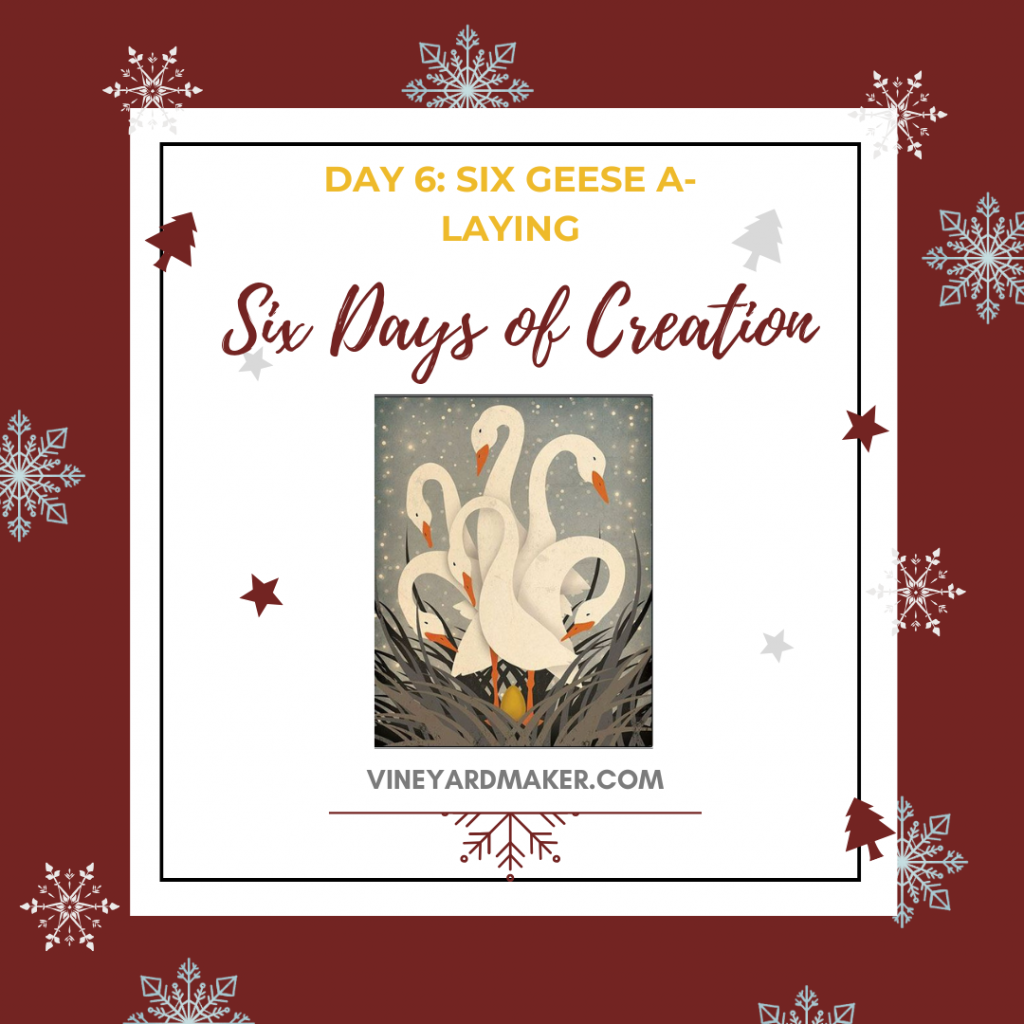
“God saw all that he had made, and it was very good. And there was evening, and there was morning—the sixth day.” Genesis 1:31 (NIV)
Reflection:
The six geese represent the six days of creation, reminding us of God’s power and creativity. Celebrate the beauty of God’s world and your role in stewarding it.
Questions to Ponder:
- How do I see God’s creativity reflected in creation?
- What steps can I take to care for the world around me?
The sixth day of Christmas, represented by “six geese a-laying,” offers a beautiful connection to the sixth day of creation described in Genesis 1:24–31. This day is a profound reminder of God’s creative power, His gift of life, and the unique calling He gave humanity as stewards of His creation.
The Sixth Day of Creation: A Gift of Life and Responsibility
On the sixth day, God filled the earth with living creatures, from livestock to wild animals. His final and most significant act of creation was humanity, made in His image (Genesis 1:27). This divine act set humanity apart, granting us the unique responsibility to reflect God’s character and steward His creation. The imagery of “six geese a-laying” mirrors this theme of life and abundance. Just as geese lay eggs, promising new life, God’s creation reflects His provision and the ongoing cycle of renewal.
Six Geese A-Laying: Symbolism of New Life and Renewal
Geese laying eggs are a symbol of potential, growth, and sustenance—themes deeply tied to God’s work on the sixth day. As Christians, we can see the laying of eggs as a metaphor for God’s invitation to participate in the nurturing and flourishing of life. Each egg holds the promise of new beginnings, much like the hope we find in Christ. Through Jesus, the image of God, tarnished by sin, is restored, offering us new life and the opportunity to live in harmony with God’s purpose.
The Sixth Day’s Call to Stewardship and Reflection
The sixth day’s creation story doesn’t end with God’s proclamation that His work was “very good.” It also includes a charge to humanity: to fill the earth, subdue it, and have dominion over all living creatures (Genesis 1:28). This dominion isn’t about exploitation but stewardship. It’s a call to care for creation as God’s representatives, reflecting His love and creativity in how we interact with the world.
Practical Theology: Living as Image-Bearers of God
The connection between the sixth day of creation and the sixth day of Christmas reminds us that life is sacred and purposeful. As image-bearers of God, we’re invited to nurture growth—in our own lives, in others, and in the natural world. This requires intentional care, thoughtful action, and a commitment to reflect God’s character in our daily lives. The “six geese a-laying” inspire us to consider how we can nurture spiritual and physical life, honoring God’s creative work.
Reflection Questions for Spiritual Growth
- How do you see the image of God reflected in your life and the lives of others?
- What steps can you take to better steward the responsibilities God has entrusted to you?
- Where in your life is God calling you to nurture new growth, like a goose protecting her eggs?
- How does the promise of new life in Christ inspire you to live with greater hope and purpose?
- Take a moment to observe creation around you. What does it reveal about God’s character and provision?
Conclusion: Embracing the Gift of Life
Day 6 of the Christmas season is a powerful reminder of God’s creative power, His provision, and His call to stewardship. As we reflect on the symbolism of the “six geese a-laying” and the sixth day of creation, let’s embrace our role as image-bearers of God and live out His purpose with intention and care. New life—both physical and spiritual—is a gift that calls for gratitude, reflection, and action.
The sixth day reminds us that life is a sacred gift. May we honour it by reflecting God’s image in all we do and by embracing the new life He offers through His Son.